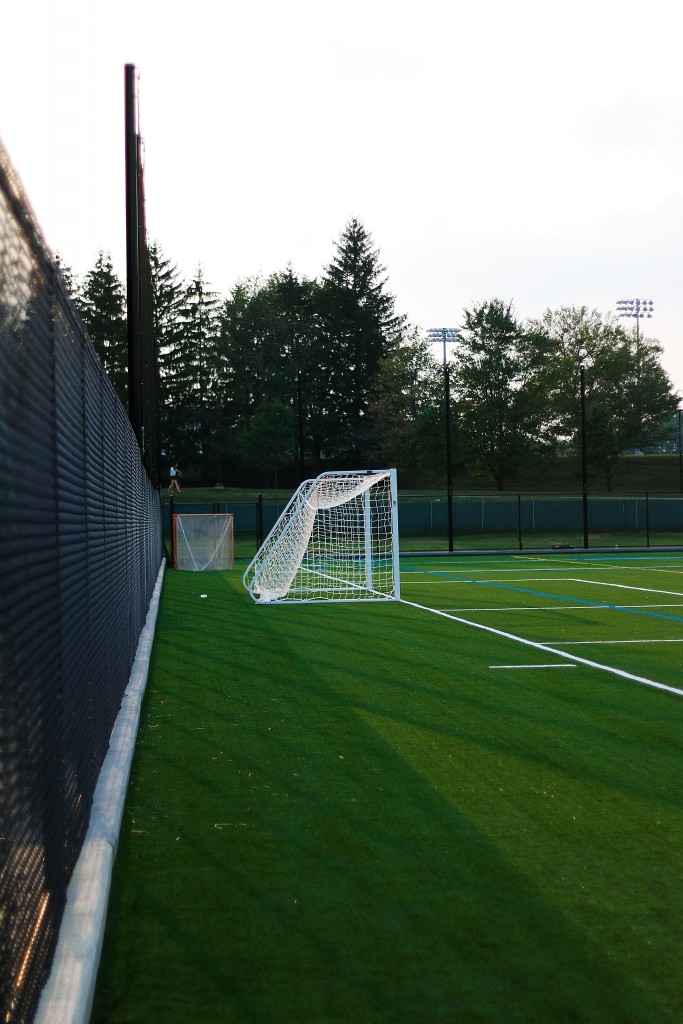
The Binghamton men’s and women’s soccer teams, as well as the men’s and women’s lacrosse teams, have competed on turf since the Bearcats Sports Complex opened in 2007. Now, all Binghamton students will be offered the same opportunity. On August 30, Binghamton University debuted its new Recreation Turf Field.
Intramural sports have consistently had to battle the Binghamton weather. Games were oftentimes cancelled due to rain and poor field conditions associated with it. The implementation of the all-turf field is believed to have alleviated that issue.
“We have been exploring possibilities to construct an artificial turf field for intramural programming and club sports use for several years,” Cindy Cowden, the associate director of Campus Recreation, wrote in an email to Pipe Dream. “An artificial playing field will allow Campus Recreation to cancel fewer practices and games that are already scheduled — especially spring softball which was canceled for three consecutive years due to poor grass field conditions.”
Students seem pleased about the addition of a turf field and the chance to follow a more stable schedule.
“I think it’s a great idea,” said Alexander Boudreau, a first-year graduate student studying mechanical engineering who has participated in intramural flag football, soccer and softball. “The biggest concern with the grass field was that they would always cancel it due to rainouts. I had a softball season where we didn’t play a single game.”
The field is also surrounded by lights, which will also allow the intramural program to expand its hours. In the past, outdoor intramural sports were only available to students at specific times due to class schedules and a lack of daylight. Now, games can be played at virtually any time.
Campus Recreation has already begun to shift and expand its intramural sports programs for this fall. Flag football, which had previously been held on Saturday and Sunday afternoons, will now be played Sunday evenings through Tuesday evenings, under the lights. Bubble soccer, which last year was held indoors at the West Gym, has now been moved outside two nights a week, and a brand new kickball league has been added to the schedule as well. Even with these new additions, Campus Recreation is still looking for ways to expand.
“With longer seasons and more time available to play, we can explore the options for growth of programs that continue to fill up year after year, or new sports that we have not previously had the field resources to support,” Cowden wrote.
The more varied schedule will give students increased opportunities to participate in intramural sports, especially those who have other commitments.
However, the price for intramural sports has risen significantly. From 2001 to 2014, the registration fee for each intramural team besides four-team bowling was $10. In 2014-2015, the price was doubled to $20.
“We increased our league fees … with the primary purpose to meet our growing payroll based on the raise in minimum wage,” Cowden wrote in an email. “We were not allocated the full amount requested by the [Student Association] to assist in the growing needs of staff employment … We also implemented our online registration system IMLeagues that bumped the budget and fee up a nominal amount.”
For the 2015-2016 season, the cost will rise again. Participation in almost all intramural sports will now cost a team between $30 and $35.
“We are once again faced with higher payroll costs for student staffing — due in part to both another minimum wage increase and an expanded schedule of offerings with the turf field,” Cowden added. “We did not receive an increase in allocation from the SA so all budgeted items have not been met. A rise in team registration fees based on the nature of the specific sport was necessary to continue with programming.”
This $20-$25 increase in price over the last two years has irritated some who have previously participated in intramural sports.
“I think it’s stupid and moronic and is just a terrible way to get people excited about things, because then there is just another fee,” said Ricki Zimmerman, a senior majoring in English who has participated in bubble soccer and volleyball. “But at the same time I think it’s genius on the part of the University because people are going to play intramural sports and they’re going to pay the fee either way.”
However, others understand the necessity for a rise in cost with the addition of improved facilities.
“I feel like intramural sports are something that students have a right to do; it’s part of the college experience,” sad Jamie Jarett, a senior majoring in industrial and systems engineering who has participated in intramural soccer, bubble soccer and dodgeball. “Then again, I know that that money is going to the turf field being there and that’ll help being able to play more games. So I feel like it goes both ways.”


